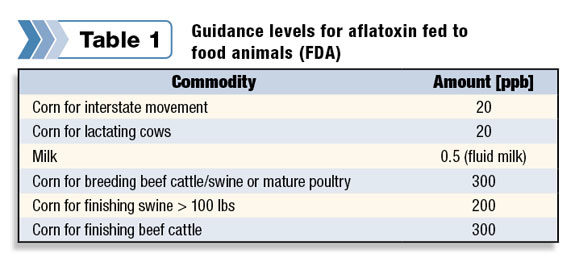Pictures of stunted corn cobs in the Corn Belt of the U.S. or the barren wheat fields of Ukraine call world food affairs into mind. What many of us do not take into consideration is that the current drought does not only affect crop yields – the U.S.’ corn yields are supposed to be 13 percent lower than in the previous year – but also heavily affects the quality of corn.
Aflatoxins have received greater attention than any other mycotoxins. Oilseeds, spices, ground nuts, tree nuts, and especially corn are some of the feedstuffs in which this group of mycotoxins most frequently occurs.
Produced by fungi of the Aspergillus spp. – primarily Aspergillus flavus and Aspergillus parasiticus – aflatoxins are a group of approximately 20 fungal metabolites. Aflatoxin B1, the most toxic of the aflatoxins, is the most potent naturally occurring chemical liver carcinogen known.
Due to their demonstrated carcinogenic effects in susceptible animals and their acute toxic effects in humans, the U.S. Food and Drug Administration (FDA) has enforced regulatory limits on the concentration of aflatoxins in foods and feeds.
The role of drought
Weather conditions are an important contributor to mold infection. Although generally designated as a storage mycotoxin, the pre-harvest contamination of feeds with aflatoxins is very prominent if conditions are favorable. Along with grains, corn is the most susceptible to aflatoxin contamination in the U.S.
The fungus responsible for aflatoxin is quite common, but its population increases during hot, dry weather and nighttime temperatures greater than 70ºF during corn silking stage.
Generally speaking, whether the fungi produce aflatoxins depends on drought stress and rainfall, suitability of crop genotype for its climate, insect damage and agricultural practices.
When aflatoxin B1 becomes aflatoxin M1
After being ingested by dairy cows through contaminated feed, aflatoxin B1 is converted into aflatoxin M1 by enzymatic activities primarily in the liver. The newly formed metabolite will then be excreted in the urine and in the milk of the cow.
At this stage, this mycotoxin is no longer only an animal health concern, but poses a significant public health issue. Due to the transmission of aflatoxin M1 into milk, in the European Union, for example, milk is even discarded with an aflatoxin M1 level higher than 0.05 ppb.
Aflatoxin B1: Silently damaging the cow’s liver
After ingestion of aflatoxin, its toxicity may be exerted in several ways – from altered intestinal integrity to immunosuppression, hemorrhage, growth inhibition and acute liver damage – depending mainly on the levels at which it is consumed.
Less visible to the naked eye is the biotransformation of aflatoxin in the liver. Among other possibilities, this molecule may bind to liver proteins, potentially causing acute aflatoxicoses, or it may bind to DNA, a step precursor for aflatoxin-induced liver cancer.
These factors also may negatively affect cow health and performance, especially in the period around parturition, as cows undergo tremendous physiological changes during this production stage. Liver function is acknowledged to be altered due to metabolic demands, especially during late gestation and early lactation.
After calving, the initiation of milk synthesis and the rapidly increasing milk production greatly increase demands for glucose synthesis at a time when feed intake has not reached its maximum. Due to this fact, many metabolic changes occur which might lead to fat deposition in the liver and contribute to liver failure, straining cows extremely sensitive to toxin challenges.
The way around it
Whether you look at it from a milk quality and consumer health perspective or from the perspective of your own herd’s health and performance, aflatoxin contamination of feed must be properly counteracted.
With these extended risks of aflatoxin contamination of feed, treatment of already-contaminated corn and the prevention of continuing mold growth during storage play a very important role for producers.
Mold inhibitors, such as organic acids, can help to prevent mold growth during storage when moisture content rises above 12 to 14 percent or when poor storage conditions are a problem. The mold inhibitors prevent the growth of Aspergillus spp. during storage, but they are not able to destroy or modify aflatoxins which have already been produced by Aspergillus spp . prior to harvest.
How to treat corn which is contaminated with aflatoxins already prior to harvest
There are several products on the market, mainly containing clay minerals, which have proven effects in binding aflatoxins and preventing their adsorption.
But the binding of aflatoxins alone is not enough to face the problems aflatoxin-contaminated corn causes. Even if aflatoxins are bound, the liver is still challenged, especially in high-performing animals. In order to provide natural protection of the liver and improve hepatic metabolism, there are products on the market which not only reduce the adsorption of aflatoxins but yield further benefits.
Products which contain additional selected herbal extracts, essential oils and zinc not only adsorb aflatoxins, but help to support the whole metabolism, enabling the cow to reach and retain high performance.
Several studies have proven that along with binding aflatoxins and other relevant mycotoxins, products with a complete formulation of these synergistic compounds were effective in controlling reproductive problems, immunosuppression, hepatotoxicity and gastrointestinal disturbances related to mycotoxicosis. In times such as those we are facing now, this could be the difference in the sustenance of your herd health program and future profitability. PD
References omitted due to space but are available upon request. Click here to email an editor.

Kerstin Reiners
Product Manager
EW Nutrition GmbH







